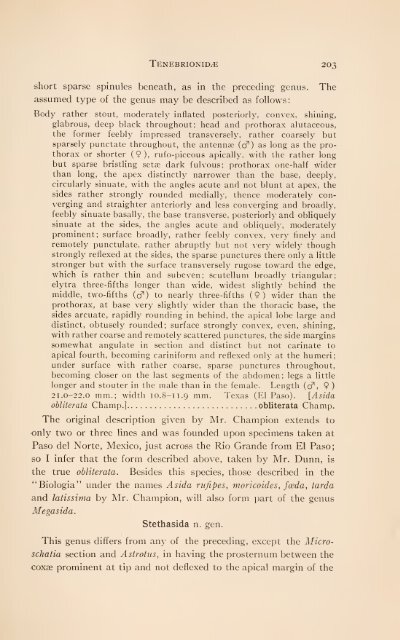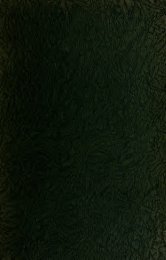Memoirs on the coleoptera
Memoirs on the coleoptera
Memoirs on the coleoptera
Create successful ePaper yourself
Turn your PDF publications into a flip-book with our unique Google optimized e-Paper software.
TENEBRIONID/E 203<br />
short sparse spinules beneath, as in <strong>the</strong> preceding genus. The<br />
assumed type of <strong>the</strong> genus may be described as follows:<br />
Body ra<strong>the</strong>r stout, moderately inflated posteriorly, c<strong>on</strong>vex, shining,<br />
glabrous, deep black throughout; head and prothorax alutaceous,<br />
<strong>the</strong> former feebly impressed transversely, ra<strong>the</strong>r coarsely but<br />
sparsely punctate throughout, <strong>the</strong> antennae (cf ) as l<strong>on</strong>g as <strong>the</strong> prothorax<br />
or shorter (9), rufo-piceous apically, with <strong>the</strong> ra<strong>the</strong>r l<strong>on</strong>g<br />
but sparse bristling seta? dark fulvous; prothorax <strong>on</strong>e-half wider<br />
than l<strong>on</strong>g, <strong>the</strong> apex distinctly narrower than <strong>the</strong> base, deeply,<br />
circularly sinuate, with <strong>the</strong> angles acute and not blunt at apex, <strong>the</strong><br />
sides ra<strong>the</strong>r str<strong>on</strong>gly rounded medially, <strong>the</strong>nce moderately c<strong>on</strong>-<br />
verging and straighter anteriorly and less c<strong>on</strong>verging and broadly,<br />
feebly sinuate basally, <strong>the</strong> base transverse, posteriorly and obliquely<br />
sinuate at <strong>the</strong> sides, <strong>the</strong> angles acute and obliquely, moderately<br />
prominent; surface broadly, ra<strong>the</strong>r feebly c<strong>on</strong>vex, very finely and<br />
remotely punctulate, ra<strong>the</strong>r abruptly but not very widely though<br />
str<strong>on</strong>gly reflexed at <strong>the</strong> sides, <strong>the</strong> sparse punctures <strong>the</strong>re <strong>on</strong>ly a little<br />
str<strong>on</strong>ger but with <strong>the</strong> surface transversely rugose toward <strong>the</strong> edge,<br />
which is ra<strong>the</strong>r thin and subeven; scutellum broadly triangular;<br />
elytra three-fifths l<strong>on</strong>ger than wide, widest slightly behind <strong>the</strong><br />
middle, two-fifths (cf) to nearly three-fifths (9) wider than <strong>the</strong><br />
prothorax, at base very slightly wider than <strong>the</strong> thoracic base, <strong>the</strong><br />
sides arcuate, rapidly rounding in behind, <strong>the</strong> apical lobe large and<br />
distinct, obtusely rounded; surface str<strong>on</strong>gly c<strong>on</strong>vex, even, shining,<br />
with ra<strong>the</strong>r coarse and remotely scattered punctures, <strong>the</strong> side margins<br />
somewhat angulate in secti<strong>on</strong> and distinct but not carinate to<br />
apical fourth, becoming cariniform and reflexed <strong>on</strong>ly at <strong>the</strong> humeri;<br />
under surface with ra<strong>the</strong>r coarse, sparse punctures throughout,<br />
becoming closer <strong>on</strong> <strong>the</strong> last segments of <strong>the</strong> abdomen; legs a little<br />
l<strong>on</strong>ger and stouter in <strong>the</strong> male than in <strong>the</strong> female. Length (cf , 9<br />
21.0-22.0 mm.; width 10.8-11.9 mm. Texas (El Paso). [Asida<br />
obliterata Champ.] obliterata Champ.<br />
The original descripti<strong>on</strong> given by Mr. Champi<strong>on</strong> extends to<br />
<strong>on</strong>ly two or three lines and was founded up<strong>on</strong> specimens taken at<br />
Paso del Norte, Mexico, just across <strong>the</strong> Rio Grande from El Paso;<br />
so I infer that <strong>the</strong> form described above, taken by Mr. Dunn, is<br />
<strong>the</strong> true obliterata. Besides this species, those described in <strong>the</strong><br />
"Biologia" under <strong>the</strong> names Asida rufipes, moricoides, fceda, tarda<br />
and latissima by Mr. Champi<strong>on</strong>, will also form part of <strong>the</strong> genus<br />
Megasida.<br />
Stethasida n. gen.<br />
This genus differs from any of <strong>the</strong> preceding, except <strong>the</strong> Micro-<br />
schatia secti<strong>on</strong> and Astrotus, in having <strong>the</strong> prosternum between <strong>the</strong><br />
coxae prominent at tip and not deflexed to <strong>the</strong> apical margin of <strong>the</strong><br />
)



